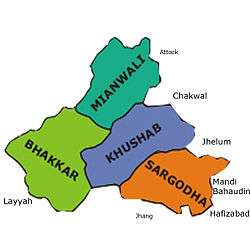Chak 128 NB
Chak 128 NB is a village situated in the Sillanwali Tehsil of the Sargodha District in Punjab, Pakistan. Its neighbouring villages are Chak 130 NB, Chak 125 NB, Chak No. 129 NB and Jahanawala. The village is mainly an agricultural area. The nearest city is Sillanwali, which is also the Tehsil headquarters and nearest police station.
| Chak 128 NB | |
|---|---|
| Village | |
 Chak 128 NB Location in Pakistan | |
| Coordinates: 31°50′10″N 72°29′45″E / 31.83611°N 72.49583°ECoordinates: 31°50′10″N 72°29′45″E / 31.83611°N 72.49583°E | |
| Country | Pakistan |
| Province | Punjab |
| District | Sargodha |
History
In the 19th Century, as part of a grand engineering programme of British Government of India, built a huge network of irrigation canals to settle what was then a piece of scrubland known as the Kirana Bar. Villages were built along canals, and given numbers. So Chak 128 NB means village number 128 and NB means North Branch canal. So the name of the village basically means 128th village number on the North (Shumali) Branch canal.
Tribes and clans
Most of the villagers are indigenous to the region, unlike other colony villages, where settlers were brought from other parts of the Punjab. The exception are a community of Mirpuris, originally from Azad Kashmir. The locals refer to them as Mangla Dami (builders of the Mangla Dam).
The rest of the population belongs to various Kirana Bar tribes, such as the Moand, Kalyar, Khichi, Khokhar etc. While laborers have settled from the adjoining areas of Jhang District. Many belong to the Muslim Shaikh community.
Agriculture
The village relies primarily on agriculture, which the main crops being wheat, sugar cane, cotton, pulses, rice and citrus.
Religion and shrines
There are three mosques in the village. All the residents are followers of the Sunni sect. Many are the murid (followers) of the Sufi saint Pir Sial Lajpal of Sial Sharif and of Hazrat Sultan Bahoo (Rahmatuuallah alah).
There is Darbar of "Hazrat Syed Chan Pir". He was a murid from Hazrat Hyder Shah of Jalalpur Sharif. Many people and murid come to the Darbar.
